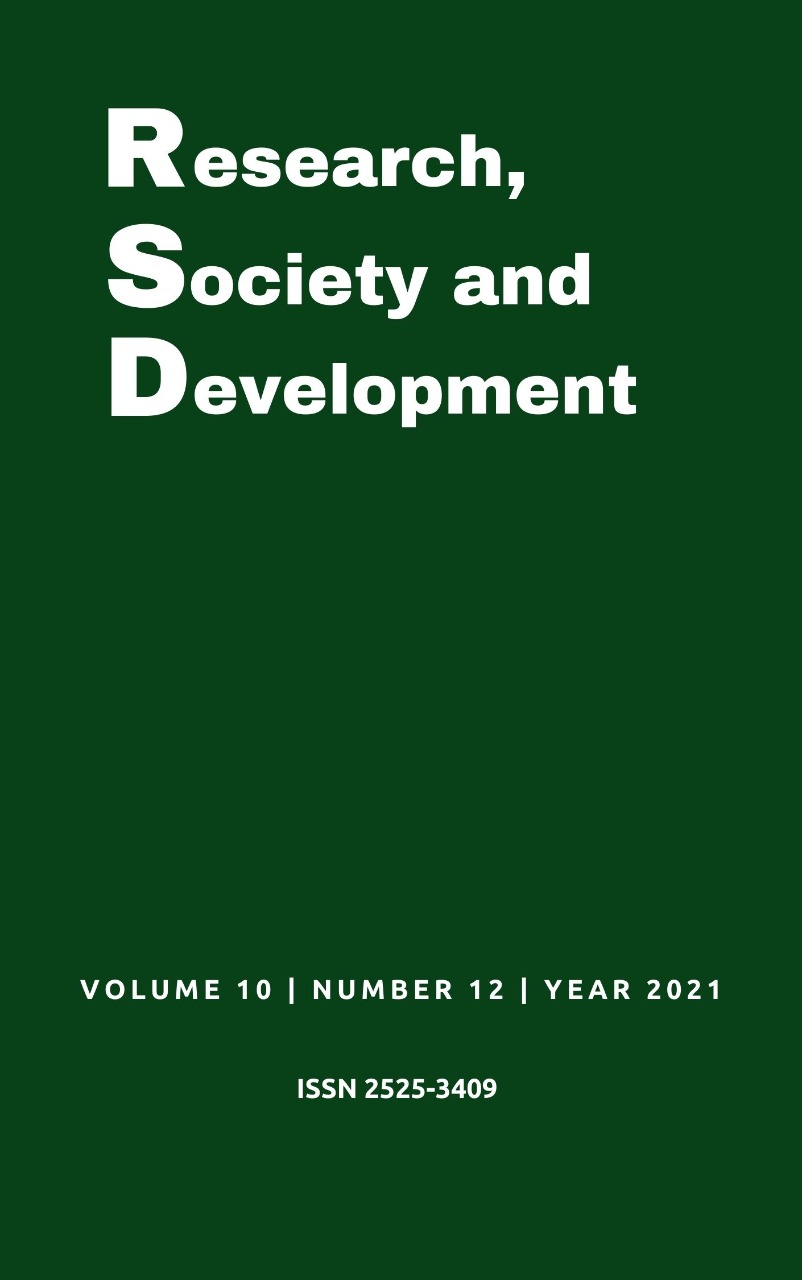Técnica cirúrgica de tunelização para recobrimento de recessão gengival – relato de caso clínico
DOI:
https://doi.org/10.33448/rsd-v10i12.20183Palavras-chave:
Retração gengival; tunelização; recessão; Cirurgia bucal; Retração gengival. ; cirurgiaResumo
O enxerto de tecido conjuntivo associado a técnica cirúrgica de tunelização, tem sido citada como uma opção favorável para o tratamento de recessões gengivais classe I e II de miller moderadas. Este presente artigo tem por objetivo relatar um caso clínico de um paciente de 43 anos, do seco masculino, selecionado para o tratamento de recessão gengival do dente 41. Após avaliação clínica e radiográfica, concluímos que se tratava de uma recessão classe I de Miller. Ficou decidido em proceder cirurgicamente com o recobrimento radicular desse dente recorrendo a técnica de tunelização. Após 1 mês do procedimento, observou-se recobrimento radicular completo, ausência de sangramento a sondagem, profundidade de sondagem de 3 mm e uma perfeita integração estética com os tecidos adjacentes. Diante do caso supracitado, fica claro que esta técnica apresenta resultados bastante previsíveis quando indicada e executada corretamente, chegando assim na obtenção de um resultado muito estético.
Referências
Saadoun AP. Current trends in gingival recession coverage part I: the tunnel connective tissue graft. Pract Proced Aesthet Dent, 2006;18:433-40.
Zuhr O, Rebele SF, Schneider D, Jung RE, Hurzeler MB. Tunnel Technique with connecrtive tissue grafit versus coronally advanced flap with enamel matrix derivative for root coverage: A RCT using #D digital methods. PartII: volumetric studies on healing dynamics and gingival dimensions. J Clin Periodontol. 2014;41:593-603.
Tsourounakis I, Sweidan C, Palaiologou AA, Maney P. Coverage of isolated, severe gingival recession: A modified technique. Clin Adv in Periodontics. 2014;4:148–53.
Ribeiro FS, Zandim DL, Pontes AEF, Mantovani RV, Sampaio JEC, Marcantonio E.
Tunnel technique with a surgical maneuver to increase the graft extension: Case report with a 3-year old follow-up. J Periodontol. 2008;79:753–8.
Bouchard P, Malet J, Borghetti A. Decision-making in aesthetics: Root coverage revisited. Periodontology 2000. 2001;27:97–120.
Dani S, Dhage A, Gundannavar G. The pouch and tunnel technique for management of multiple gingival recession defects. J Indian Soc Perio. 2014;18:776–80.
Langer B, Langer L. Subepithelial connective tissue graft technique for root coverage. J Periodontol. 1985;56:715–20.
Raetzke PB. Covering localized areas of root exposure employing the envelope technique. J Periodontol. 1985;56:397–402.
Allen AL. Use of supraperiosteal envelope in soft tissue grafting for root coverage. I. Rationale and technique. Int J Periodontics Restorative Dent. 1994;14:216–7.
Zabalegui I, Sicilia A, Cambra J, Gil J, Sanz M. Treatment of multiple gingival recessions with the tunnel subepithelial connective tissue graft: A clinical report. Int J Periodontics Restorative Dent. 1999;19:471–9.
Azzi R, Etienne D, Takei H, Fenech P. Surgical thickening of the existing gingiva and reconstruction of interdental papillae around implant-supported restorations. Int J Periodontics Restorative Dent. 2002;22:71–7.
Zühr O, Fickl S, Watchtel H, Bolz W, Hurzeler MB. Covering of gingival recessions with a modified microsurgical tunnel technique: case report. Int J Periodontics Restorative Dent. 2007;27:456–63.
Stimmelmay M, Allen E, Gernet W, Edelhoff D, Beuer F, Schlee M, et al. Treatment of gingival recession in the anterior mandible using the tunnel technique and a combination epithelialized-subepithelial connective tissue graft–a case series. Int J Periodontics
Restorative Dent. 2011;31:164–73.
Salama H, Salama M, Garber D. The tunnel technique in the periodontal plastic treatment of multiple adjacent gingival recession defects: A review. Inside Dentistry. 2008;4:78–81.
Zühr O, Rebele SF, Schneider D, Jung RE, Hurzeler MB. Tunnel technique with connective tissue graft versus coronally advanced flap with enamel matrix derivative for root coverage: A RCT using 3D digital methods. Part I: Clinical and patient-centred outcomes. J Clin Periodontol. 2014;41: 582–92.
Miller PD Jr. A classification of marginal tissue recession. Int J Periodontics Restorative Dent. 1985;5:8–13.
Han JS, John V, Blanchard SB, Kowolik MJ, Eckert GJ. Changes in gingival dimensions following connective tissue grafts for root coverage: Comparison of two procedures. J Periodontol. 2008;79:1346–54.
Shanelec DA. Periodontal Microsurgery. J Esthet Restor Dent. 2003;(Special Issue 15):18–23.
Burkhardt R, Lang NP. Coverage of localized gingival recessions: A comparison of micro- and macrosurgical techniques. J Clin Periodontol. 2005;32:287–93.
Chambrone L, Chambrone D, Pustiglioni FE, Chambrone LA, Lima LA. Can subepithelial connective tissue grafts be considered the gold standard procedure in the treatment of Miller Class I and II recession-type defects? J Dent. 2008;36:659–71.
Allen E. Subpapillary continuous sling suture method for soft tissue grafting with the tunneling technique. Int J Periodontics Restorative Dent. 2010;30:478–85.
Downloads
Publicado
Como Citar
Edição
Seção
Licença
Copyright (c) 2021 Bruna Gabrielle Pereira Silva; Márcio Américo Dias; Rafael de Aguiar Vilela Júnior

Este trabalho está licenciado sob uma licença Creative Commons Attribution 4.0 International License.
Autores que publicam nesta revista concordam com os seguintes termos:
1) Autores mantém os direitos autorais e concedem à revista o direito de primeira publicação, com o trabalho simultaneamente licenciado sob a Licença Creative Commons Attribution que permite o compartilhamento do trabalho com reconhecimento da autoria e publicação inicial nesta revista.
2) Autores têm autorização para assumir contratos adicionais separadamente, para distribuição não-exclusiva da versão do trabalho publicada nesta revista (ex.: publicar em repositório institucional ou como capítulo de livro), com reconhecimento de autoria e publicação inicial nesta revista.
3) Autores têm permissão e são estimulados a publicar e distribuir seu trabalho online (ex.: em repositórios institucionais ou na sua página pessoal) a qualquer ponto antes ou durante o processo editorial, já que isso pode gerar alterações produtivas, bem como aumentar o impacto e a citação do trabalho publicado.

